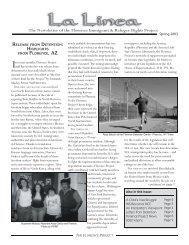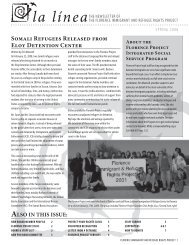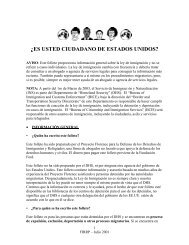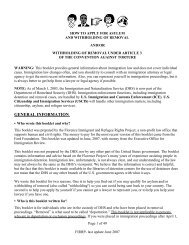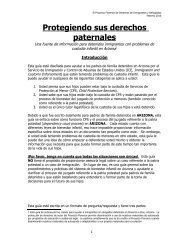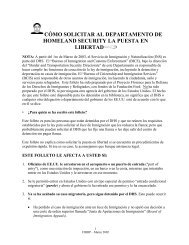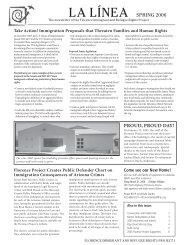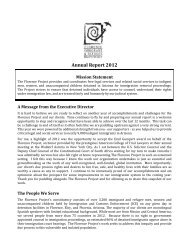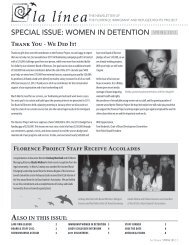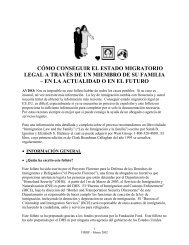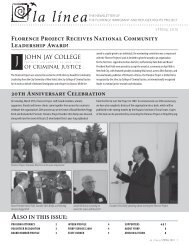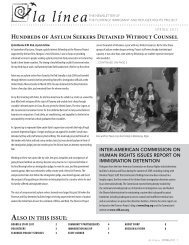quick reference chart and annotations for determining immigration ...
quick reference chart and annotations for determining immigration ...
quick reference chart and annotations for determining immigration ...
You also want an ePaper? Increase the reach of your titles
YUMPU automatically turns print PDFs into web optimized ePapers that Google loves.
Immigrant Legal Resource Center, Florence Immigrant <strong>and</strong> Refugee Rights Project,<br />
Maricopa County Public Defender August 2012<br />
A1 or A2 is a class 1 misdemeanor, except that it is a class 6 felony if the offense is committed in<br />
retaliation <strong>for</strong> certain anti-crime activities. A3 is a class 4 felony.<br />
Crime Involving Moral Turpitude (CMT): Divisible. The Ninth Circuit has held that a<br />
conviction <strong>for</strong> Criminal Threats under Cali<strong>for</strong>nia law is a CMT. Latter-Singh v. Holder, 668 F.3d 1156,<br />
1158 (9th Cir. 2012). However, in finding it to be categorically a CMT, the Ninth Circuit relied on three<br />
aspects of the Cali<strong>for</strong>nia statute that are not necessarily present in the Arizona statute. First, the Arizona<br />
statute does not require a threat of “death or great bodily injury,” since the plain language of the statute<br />
includes threats of physical injury, damage to property, or serious public inconvenience. Second, the<br />
Arizona threats statute does not require an intent that the victim believe the threat will be carried out since<br />
the legislature specifically amended the language in 1994 to delete a requirement that there be an “intent<br />
to terrify.” 1994 Ariz. Sess. Laws, ch. 200, § 11. Third, the Arizona threats statute does not require intent<br />
<strong>and</strong> may be violated by a mens rea of mere negligence. In re Kyle M., 200 Ariz. 447, 449 (Ariz. Ct. App.<br />
2001); In re Ryan A., 39 P.3d 543 (AZ 2002). There<strong>for</strong>e, while the statute is not categorically a CMT,<br />
defense counsel should attempt to keep these elements out of the record of conviction or any other<br />
documents whenever possible.<br />
Because A3 requires the person to threaten in order to support gang or racketeering activity, it is<br />
likely that the DHS will charge it as a CMT. Criminal defense counsel should attempt to avoid this plea,<br />
or if that is not possible to keep the record of conviction clear of damaging in<strong>for</strong>mation.<br />
Aggravated Felony as a Crime of Violence: Both A1 <strong>and</strong> A2 are misdemeanors that cannot<br />
sustain a sentence of a year, but will be held a class 6 felony if done in retaliation <strong>for</strong> certain activities.<br />
There counsel should obtain a sentence of 364 days or less, or keep the record vague between A1 <strong>and</strong> A2.<br />
A1 may be charged as a crime of violence, but <strong>immigration</strong> counsel will have strong arguments that it<br />
lacks the requisite intent since it is a strict liability offense. In re Kyle M., 200 Ariz. 447, 449 (Ariz. Ct.<br />
App. 2001). A2 is not a crime of violence since it does not necessarily involve a threat to use <strong>for</strong>ce on<br />
people or property (e.g., it could involve threatening to pull a fire alarm).<br />
A3 can be a felony <strong>and</strong> will likely be charged as a crime of violence. See Rosales-Rosales v.<br />
Ashcroft, 347 F.3d 714 (9th Cir. 2003) (Calif. P.C. § 422, which punishes "[a]ny person who willfully<br />
threatens to commit a crime which will result in death or great bodily injury to another person, with the<br />
specific intent that the statement ... is to be taken as a threat, even if there is no intent of actually carrying<br />
it out,” held a crime of violence).<br />
Other Grounds: Domestic Violence/Child Abuse, Ab<strong>and</strong>onment or Neglect. A1 will be<br />
charged as a deportable crime of domestic violence if the conviction specifically cites § 13-3601 in the<br />
judgment, or if the record of conviction otherwise establishes that the victim had the requisite domestic<br />
relationship. 8 USC §1227(a)(2)(E)(i). Immigration counsel can argue that the statute does not have the<br />
requisite mens rea to be a “crime of violence” <strong>and</strong> thus cannot be a “crime of domestic violence” but<br />
<strong>immigration</strong> judges may not agree. See Aggravated Felony, above. No sentence is required <strong>and</strong> a<br />
misdemeanor will suffice. Consider a plea to assault, § 13-1203(A)(3). See Note: Domestic Violence. If<br />
the victim is a minor <strong>and</strong> the age of the victim appears in the record of conviction, a conviction would be<br />
removable under the ground of child abuse, neglect, or ab<strong>and</strong>onment. Matter of Velazquez-Herrera, 24<br />
I&N Dec. 503 (BIA 2008). Immigration counsel would have strong arguments against this if the age of<br />
the victim was not “actually required” in order to convict the defendant of the offense. United States v.<br />
Aguila-Montes de Oca, 655 F.3d 915, 940 (9th Cir. 2011) (en banc).<br />
Arizona Criminal Chart with Explanatory Endnote – August 2012<br />
22



